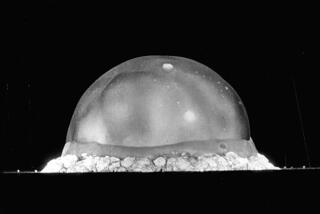The Cutting Edge: COMPUTING / TECHNOLOGY / INNOVATION : Some Myths Point to a Truth About Ourselves
- Share via
Like so many whose lives never recover from a brief moment in the spotlight, Douglas Corrigan never rose above the small part he played in a scientific and engineering triumph seven decades ago. Corrigan was a mechanic at Ryan Airlines in San Diego when T. Claude Ryan got a wire from an obscure pilot who wanted to be the first to fly the Atlantic solo nonstop.
Corrigan’s story has become a part of the folklore of Charles Lindbergh’s historic flight, and it shows that even the world of science and engineering is not immune to myths. Sometimes the most enduring impressions are the least supportable, and it is unfortunate that they tend to shape our understanding of the past.
Right up until his death a couple of months ago, Corrigan refused to admit that his famed handle of Wrong Way Corrigan was based on a myth. When authorities refused to grant him permission to try to duplicate Lindbergh’s flight, he loaded up his small plane with 325 gallons of fuel and took off on July 17, 1938, from the East Coast for California.
As every kid knows, he ended up in Ireland. His compass was 180 degrees off, he claimed, and it was all a big mistake.
Everyone who knew Corrigan knew better. I met him for the first time many years ago while writing a book on Ryan, and when I asked him about the “wrong way” flight he just smiled and walked away.
Corrigan loved a good joke. One of the early photos of the people who built the Spirit of St. Louis shows him twice. After the panoramic camera used for the photo panned by him, he ducked down behind the crowd and reappeared farther down the line just in time to be caught by the camera a second time.
A few years ago I solicited Corrigan’s help in setting the record straight on the wrong way story, but he politely declined. He had already said everything he wanted to say about it, he said. I went out to his home anyway, thinking he might change his mind if we met again in person, but he would not answer the door.
He lived in a modest home in Orange County then, but the only sign of his presence was a rural mailbox on a post by the street. It bore the name “Corrigan” in big black letters. The mailbox, of course, faced the wrong way.
His claim to have accidentally flown to Ireland was a harmless prank, but the fact that it has persisted all these years says something about the rest of us. It was such a great story we all wanted to believe it, so we kept it alive despite the fact that Corrigan was clearly putting us on. No harm done, but other myths from that same era are more damaging to the historical record.
Perhaps because the press nicknamed him Lucky Lindy, many still regard Lindbergh as a wild-eyed pilot with little grasp of the risk he was taking. Nothing could be further from the truth. Those who worked with him in San Diego during the construction of the Spirit, including Corrigan, knew him as a serious-minded student of the science of flight. He had weighed all the options and concluded that one man, flying alone in a light plane, had a better chance of succeeding than a larger crew in a heavier, more complex aircraft.
Perhaps the most troubling of all the myths from the early days of human flight involves the first men to fly a heavier-than-air machine. Popular literature frequently depicts the Wright brothers as a couple of bicycle mechanics who dreamed up a weird contraption that managed--oh-so-briefly--to remain aloft.
There are a number of aeronautical engineers in Southern California who can tell you firsthand that that’s a lot of nonsense. For years they have been working on a duplicate of the Wright brothers’ first flying machine, and they have all been astonished by the sound engineering that first effort involved.
The brothers were years ahead of their time in their understanding of the aerodynamics of flight. Everything they did had a reason behind it.
They were not just a couple of tinkerers who got lucky.
Scientific myths still abound, and they have something in common with Douglas Corrigan. When two Utah scientists claimed a few years ago to have discovered a new and harmless way to produce nuclear power in a test tube, the world wanted desperately to believe. Cold fusion held the promise of ending the planet’s energy woes forever.
My mailbox will be jammed now with irate letters from readers who still believe in cold fusion and who will be angry with me for suggesting it was all a myth. Most of them probably believe Corrigan really meant to fly to California too.
Some stories are so good we will believe them, even if all the evidence points in the opposite direction.
Lee Dye can be reached by e-mail at [email protected]
More to Read
Sign up for Essential California
The most important California stories and recommendations in your inbox every morning.
You may occasionally receive promotional content from the Los Angeles Times.










